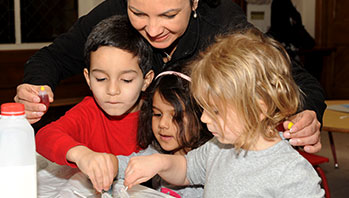- construction paper
- crayons/markers
- fruit slices from Explore Together activity (with seeds attached or placed next to slices)
- magnifying lenses
- plastic plates
- few
- fruit
- leaf
- many
- root
- seed
- stem
- vegetable
MA Standards:
Speaking and Listening/SL.PK.MA.1: Participate in collaborative conversations with diverse partners during daily routines and play.
Language/L.PK.MA.1.g: Use vocabulary in the Massachusetts Curriculum Framework for Mathematics pre-kindergarten standards to express concepts related to length, area, weight, capacity, and volume.
Mathematics/Measurement and Data/PK.MD.MA.2: Compare the attributes of length and weight for two objects, including longer/shorter, same length; heavier/lighter, same weight; holds more/less, holds the same amount.
MA Draft STE Standards:
Life Sciences/From Molecules to Organisms: Inheritance and Variation of Traits/LS1/3.A: Describe/draw and compare the body parts of animals (including themselves) and plants they are investigating [System] and explain functions of some of the observable body parts. [Structure and Function]
Life Sciences/From Molecules to Organisms: Inheritance and Variation of Traits/LS1/3.C: Use their sense in their exploration and play to gather information. [Structure and Function]
Head Start Outcomes:
Science Knowledge/Scientific Skills and Method: Collects, describes, and records information through discussions, drawings, maps, and charts.
Science Knowledge/Conceptual Knowledge of Natural and Physical Worlds: Observes, describes, and discusses living things and natural processes.
PreK Learning Guidelines:
English Language Arts/Language 2: Participate actively in discussions, listen to the ideas of others, and ask and answer relevant questions.
Science and Technology/Inquiry Skills 4: Record observations and share ideas through simple forms of representation such as drawings.
Mathematics/Measurement 13: Use estimation in meaningful ways and follow up by verifying the accuracy of estimations.
Small Group: One, Few, Many

© Commonwealth of Massachusetts, Department of Early Education and Care (Jennifer Waddell photographer). All rights reserved.
STEM Key Concepts: Many foods that animals, including humans, eat come from plants; We eat certain leaves, roots, fruits, and seeds; Fruits have seeds; Seeds hold what a plant needs to make more of itself
ELA Focus Skills: Compare and Contrast, Speaking and Listening, Follow Directions, Vocabulary
Educator Prep: Make a three-column chart with word and picture labels: One Seed; Few Seeds; Many Seeds. Place each fruit on its own plate so seeds and fruit will stay together.
Safety Tips:
- Remind children to wash their hands before and after the activity.
- Take children’s dietary needs into account before introducing them to any food items.
Focus children’s attention on the plates with the fruits and vegetables and their seeds. Ask children to identify and describe each fruit and vegetable using sensory descriptive language (taste, smell, feel, look). Then distribute squares of paper and assign each child a fruit or vegetable to draw a picture of. If you have more children than fruits and vegetables, ask some children to draw the seeds.
Distribute magnifying lenses and plastic plates. Tell children to explore the fruits, vegetables, and seeds for a few minutes and to put seeds from their exploration on their own plates. Ask questions such as,
- Can you count how many seeds are in the apple? How about in the peach?
- Do you think you can eat the olive seed? Why do you think that?
Explain to children that you are going to make a chart showing whether these fruits and vegetables have one, few, or many seeds.
Show children the chart and read the labels as you track the print. Elicit that children know what the words few and many mean. Have children discuss how many seeds are in a fruit or vegetable. Then have the child who drew the illustration for that fruit or vegetable tape it on the chart in the correct column.
Continue with the other fruits and vegetables. Review the results with children.
Educator Tip: Place leftover fruits and vegetables in re-sealable bags to use for tomorrow’s explorations. Save seeds on individual plastic plates.
